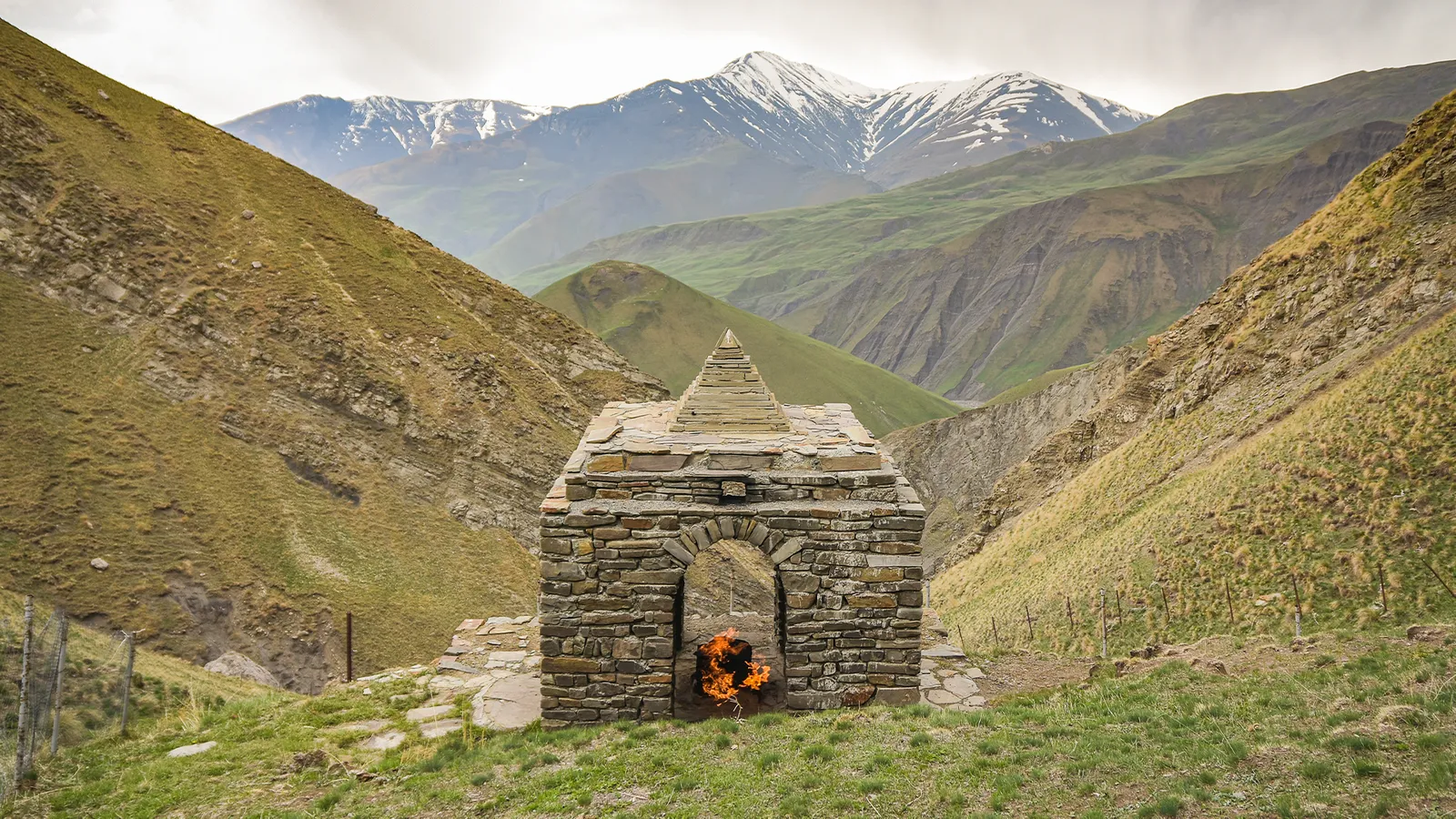Azerbaijan: The Caucasus' 'Land of Fire'
To understand Azerbaijan, one must understand the nation's sacred relationship with fire stemming from its ancient Zoroastrian roots.

The rocky peaks pierced the clouds, forming a seemingly impenetrable wall. The region's rugged terrain and unpredictable climate have historically kept humans at a distance. Yet, the constantly burning flames we found ourselves staring into have been worshipped since long before hikers reached the rocky highlands of Azerbaijan's edge in search of sweeping views.
Azerbaijan is known as "the land of fire", thanks to its vast supplies of oil and natural gas. When Marco Polo visited the Eastern Caucasus in the 13th Century, he waxed lyrical about the region's natural "oil fountains" in his memoirs. The nation's abundant natural gas reserves have played a crucial role in its economic development over the past 150 years. Yet, fire has been deeply ingrained in Azerbaijani culture and mythology since Zoroastrianism, one of the world's oldest monotheistic religions, took root in the area more than 3,000 years ago.
Fire is central to Zoroastrianism, and the element represents the light, wisdom and truth of the one God who created the world: Ahura Mazda (Wise Lord). For Zoroastrians, fire bridges the spiritual and physical – a sacred channel through which mortal believers can connect to God and gain protection against the demonic forces that live in the darkness. No ritual is conducted without the presence of fire, and temples like that near Khinaliq are built to keep these sacred flames burning for faithful communities. In fact, some scholars believe that Azerbaijan's name could be a combination of the words azar ("fire", in Farsi) and baygan ("protector") – or, rather: "he who keeps the fire".
According to Azerbaijani historian and religious scholar Kazim Azimov, there are several reasons why Zoroastrianism took root here. Azerbaijan's strategic location along the Silk Road made it easy for Zoroastrian traders to come in contact with the local population. In addition, like Iran, where Zoroastrianism originated, Azerbaijan is blessed with an abundance of natural gas reserves, making it easy to maintain the religion's sacred flames.
Today, the majority of Azerbaijanis are Muslims, but Zoroastrian beliefs, customs and traditions continue to be present in contemporary culture. Each year, to celebrate the coming of spring, Azerbaijan celebrates Nowruz (the Persian New Year). This tradition is shaped by Zoroastrian folklore, and Nowruz is one of Azerbaijan's biggest holidays.
"On Nowruz, we make fires in the yard," explained Ayshan Sharifova, a tour guide at TES Tour Baku. "We bake shekerbura, baklava, goghal [pastries]. These are the sweets prepared specifically for Nowruz. Each one of them represents a different stage of nature's awakening during springtime: shekerbura is shaped like a crescent, baklava is shaped like a star and goghal is shaped like the sun."
The Zoroastrian concept of renewal and its reverence towards nature remains strong in modern-day Azerbaijan. Nowruz falls on 21 March, but in Azerbaijan, unlike in Iran, celebrations take place throughout the four weeks preceding the holiday. "Each of the four Tuesdays prior to the holiday represents one of the four elements: water, fire, wind and earth. People celebrate by dancing, singing and playing games," said Sharifova.
For Zoroastrians, the renewal of nature following winter offers an opportunity for the renewal of the self. Fire is a useful tool for this purpose. All around Azerbaijan, bonfires are set ablaze in cities and villages and jumped over by those hoping to leave their misfortunes behind and start the new year fresh.
Material traces of Azerbaijan's Zoroastrian past are harder to come by. Some scholars believe that one of Azerbaijan's national icons, the 29m-tall Qız Qalası (Maiden's Tower) – a 12th-Century Unesco-inscribed monument set in Baku's historical Old City – could have Zoroastrian origins. When standing under the tower, two different layers of bricks can be clearly seen, and some historians posit that the lower part of the building could have had a previous life as a dakhma, a Zoroastrian funerary tower, where dead bodies were purified through excarnation.
Human remains would be placed above the towers and left for vultures to eat so the land would remain uncontaminated – another sacred element in Zoroastrianism. According to scholar and researcher KE Eduljee, dakhmas were designed to ensure that corpses and their fluids don't come into contact with the earth or run into rivers, thereby polluting the soil and rivers and spreading disease. This practice developed in small mountain valleys where arable land was scarce and disease would decimate an entire village.
Persians made Zoroastrianism the official state religion in modern-day Azerbaijan in the 6th Century BCE and altars, temples and towers dotted much of the area until the end of the Sasanian Empire in the 7th Century AD. As Zoroastrianism spread across Asia and the Caucasus, thousands of fire temples were built to protect the religion's sacred flames. But as Islam took hold in the 7th century AD, many of these ritual spaces started to disappear.
Today, Azerbaijan's population is predominantly Shia Muslim, but its two remaining ateshgah fire temples offer the best evidence of the nation's enigmatic Zoroastrian history. At Khinaliq, a small, stone pyramid stands on its rooftop and four open, arched entrances frame the green hills that rise into snowy peaks all around. The current structure is relatively recent – a sign points to its construction financed by London-based World Zoroastrian Organisation in 2016, on what are believed to be the ruins of a former altar local residents had always referred to as "ateshgah" (literally: "house of fire" in Farsi).
Azerbaijan's best-known fire temple is the ateshgah of Surakhani, a popular tourist destination just east of Baku. It's no coincidence that the majority of its visitors today arrive from India. As Islam spread in the 7th Century, Zoroastrians in Iran and Azerbaijan became increasingly marginalised, forcing many to flee their homelands and settle in communities across Central and Southern Asia. Mumbai and the nearby Indian state of Gujarat became home to a large Zoroastrian population. Today, these Indian descendants who fled the Persian Empire after refusing to convert to Islam identify as Parsis and form the largest group of Zoroastrians in the world, with an estimated 60,000 adherents – nearly half of the global Zoroastrian community.
Like the ateshgah of Khinaliq, Surakhani was also erected centuries after Zoroastrianism declined in Azerbaijan, and was built around a naturally burning flame. When French novelist Alexander Dumas visited Baku in 1858, he noted that "the whole world is aware of the Atashgah in Baku. My compatriots who want to see the fire-worshippers [a derogatory term among Zoroastrians] must be quick because already there are so few left in the temple, just one old man and two younger ones about 30-35 years old."
The structure, whose four arches open to an altar topped by a dome, dates to the 17th Century, when traders from the Indian subcontinent reached Azerbaijan via the Silk Road and stopped here during their journey. "The temple and its surrounding caravanserai welcomed people from different faiths: Hindus, Sikhs and Zoroastrians had their prayer rooms, which are still visible today," said Sharifova. Zoroastrian architectural elements here blend with Sanskrit engravings dedicated to Shiva and Ganesha. This begs the question whether the temple should be considered Zoroastrian, Hindu or the result of historical interlacing of different creeds at the crossroads of Asia and Europe.
According to Azimov, the Indigenous Talysh people living in southern Azerbaijan along the Iranian border have the nation's closest ties to Zoroastrianism today. "Fire is especially important as a sacred symbol in the south of Azerbaijan today, where the Iranian-speaking Talysh form the majority of the population. In this region, elements of nature (fire, water, rice, plants) are venerated more than elsewhere. In Soviet times, all religions were prohibited, [so] we should pay tribute to the Talysh people who, despite the ban on religion, continued to celebrate the sacred holiday of Nowruz in hiding, keeping alive Zoroastrians songs and chants."
The fire inside Surakhani ateshgah stopped burning in the late 1960s, as its source of life – methane – was directed elsewhere. But in 1975, the castle-like site was reopened as a museum and its flames reignited once more, thanks to gas piped in from Baku.
Since Azerbaijan gained independence in 1991 after the fall of the USSR, the country has sought to reclaim its identity and acknowledge its complex Zoroastrian roots. "I believe that the Azeri people are still experiencing the influence of atheistic Soviet traditions and the historical hostility of Islam toward Zoroastrianism is still alive in the memory of the local population," said Azimov. "In the Talysh communities, we have seen a renewed interest in Zoroastrian scripts in recent years. Elsewhere, the sacred fire of ancient Zorostrians has acquired a new secular meaning, impacting non-religious lifestyles and customs of contemporary Azerbaijanis, as seen during Nowruz."
After dragging ourselves through ankle-deep snow, my hiking partners and I eventually reached the 3,751m peak of Mount Aliyev six hours after setting out. After unfurling the Azerbaijan flag for a few photos, we began our descent before the weather turned.
Back at our base camp, the flames inside the ateshgah continued to burn, despite the driving rain and wind. As we left, I looked back at the lonely temple and its ever-burning flame. Perhaps it can still function as a window into the multicultural past of a land forever at the crossroads of people, continents and faiths.
-bbc







